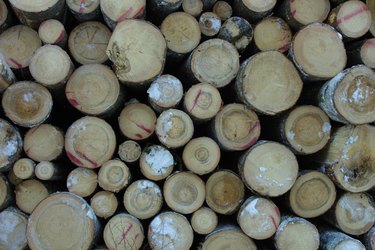Things You'll Need
Penetrating oil sealer
Wood stain
Brushes
Rags
Gloves
Log chinking compound
Putty knife
Caulking gun
Paint brush
Airless sprayer
Eye protection
Dust mask

Pine logs are readily harvested, sustainable and natural. They offer strength, durability, warmth and shelter. For hundreds of years woodworkers have crafted various species of pine logs into barns, sheds, stables, hunting lodges and beautiful homes. Pine logs are also widely used in the construction of rustic log home furniture. Because they are a natural material that have been exposed to the elements, pine logs require preventive maintenance, cleaning and care.
Step 1
Vacuum or dust interior logs on a regular basis. Wood smoke, cooking greases and film produced by gas heat builds up on the logs over time, creating a dulling film.
Video of the Day
Step 2
Examine interior logs. Are they sealed with a penetrating oil sealer or stain? Have they been varnished or coated with Polyurethane? If oil has been used on the logs, wipe them down with a soft cloth and a commercial cleaner/polish such as "Liquid Gold". This will cut the oily residue and restore the logs to their original beauty. Logs can also be cleaned with organic oils. Choose lemon, orange or cedar oil, applied with a soft cloth. These organic oils also repel spiders and other pesky insects. Logs that have been varnished or coated with a top film sealer, need only to be wiped down with a bio-degradable mild de-greaser soap and water solution such as "Dawn" detergent.
Step 3
Interior logs that have been varnished or coated with a top film sealer, need only to be wiped down with a bio-degradable mild de-greaser soap and water solution.
Step 4
Inspect exterior logs annually. Look for water damage, fungi, mold or insect infestation. Repair and treat as required. Repair and replace chinking as required. Chinking can be applied with a caulking gun or putty knife. Follow manufacturer's instructions on packaging label.
Step 5
Seal logs with an application of oil-based penetrating sealer. Stain may be added to the sealer to intensify or change the color of the logs. Sealer can be applied with a wide, soft paint brush or airless sprayer.
Warning
Never use a varnish, shellac, Polyurethane or other film type coating finish on exterior logs. They are a natural building material that needs to "breathe" to allow moisture trapped in the logs to evaporate.
Video of the Day